The New Gastronome
Maíz, Mujeres And Mole!
The Flavors of Oaxaca
by Paula Thomas
by Paula Thomas
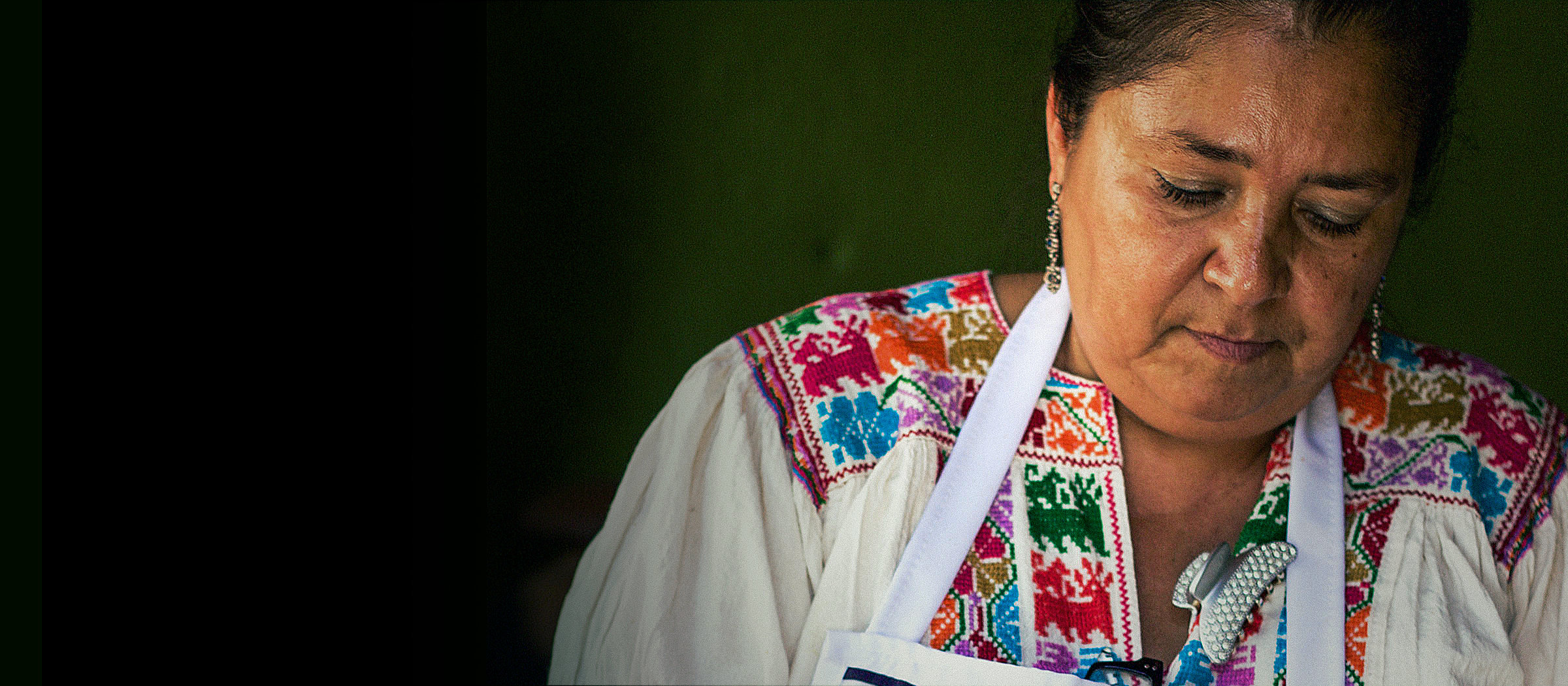
It’s Thursday morning and the streets of Ejutla del Crespo, a small town outside Oaxaca city, begins to fill with farmers and merchants from nearby towns. On the outskirts of the market, on a lot the size of a football stadium, dozens of trucks and large caravan cars unload goats, chickens, sheep, pigs, and other small animals for sale or to exchange for other goods.
Our bus struggles to get through the crowded streets as we arrive to the center of town, next to the start of the market. A lady walks down the street holding two chickens by their feet, next to a man pulling on a goat with a rope around its neck.
We follow our guide Dennis through the streets flooded with vegetable and fruit stands protected from the sun by large tarps. Suddenly, she stops in front of a house and knocks. The door opens and behind it a sweet looking woman with white hair in a neatly wrapped bun, glasses and an apron with the drawing of a bunny welcomes us, “Bienvenidos, pasen, pasen, esta es su casa.”
The long hallway behind the door opens to a large paved patio adorned with abundant tropical plants and flowers; birds chirping from the cages hang between the oversized ferns. Abuelita, as we lovingly call our hostess, introduces us to her daughter who promptly rushes us out of the house and into the market. She weaves herself into the thick crowd, like a thread into a quilt, as we struggle to keep up with her quick steps. Hundreds of vendors cover entire blocks with endless lines of produce; piles of squashes, eggplants, beans, potatoes, tomatoes, and tables full of multicolor chilies. Spices like turmeric, cumin, paprika, pepper, coriander, dried and fresh herbs from thyme, rosemary, and sage, to hierba santa, all spilling into the narrow walkway.
“Loud quaking invades the otherwise tranquil, green backyard, as a commotion of hands hassle to catch our future lunch.”
We scurry through the meat market where entire animals hang from their feet, and skilled men hand-slice large flats of muscles into paper-thin sheets of meat. A sudden stop on the way out from the meat market, as our group gathers around two ladies selling tejate, a cold chocolate drink made with toasted corn, cinnamon, and mamey, served in a mug-size gourd. We pass the gourd vessel around and blow on the foam formed on top of the drink, “You can drink that too,” the vendor suggests. The cold, sweet and slightly floral drink is a welcome respite on a rather hot day at the market.
We return to the house ready to begin our traditional Oaxacan cooking class with the local women who learnt from their mothers and grandmothers; a vital piece of our study abroad course in Oaxacan food culture[1]. We begin to exchange pleasantries around the kitchen when one of the ladies shouts “La gallina, se salio,” the hen escaped. Loud quaking invades the otherwise tranquil, green backyard, as a commotion of hands hassle to catch our future lunch.
➡ Click images to enlarge
With the hens back in the cage, we are summoned to a corner of the patio under a palm tree to talk about the chickens, while one of the master cooks hold one of them by the feet. Without hesitation, she slices the animal’s throat above a bucket to catch the pouring blood. The animal squirms and shakes as the life falls from its feathers. Some of us walk away from witnessing the reality of a carnivore diet, which won’t keep us from later enjoying the flavors of the sacrifice.
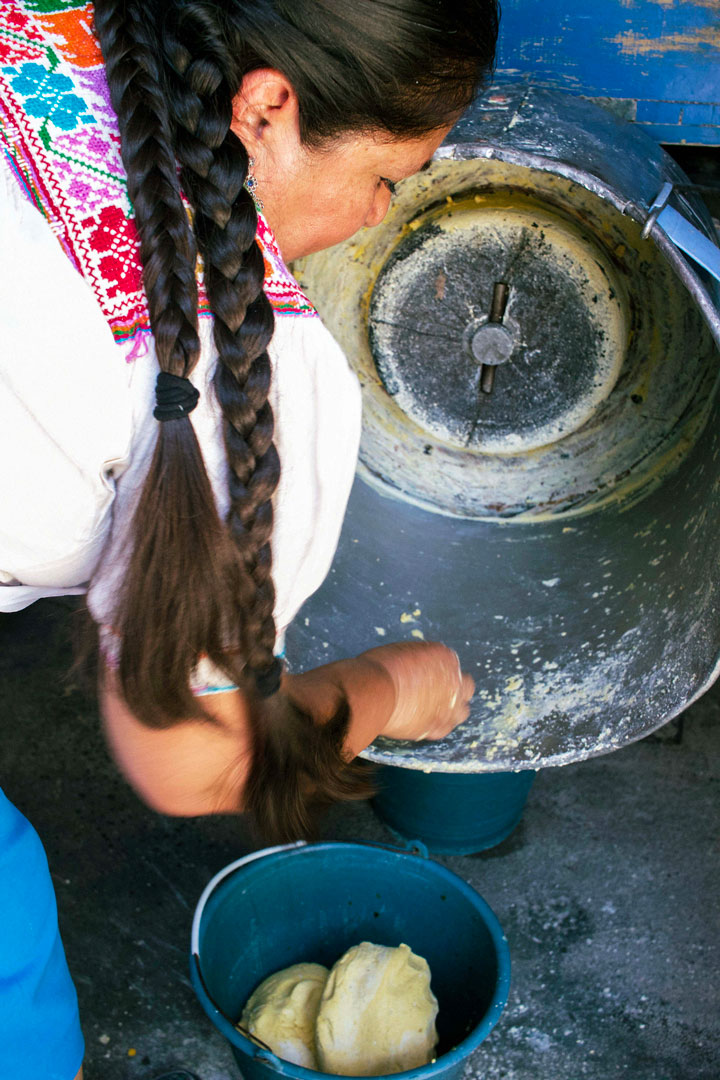 Grinding corn to obtain dough to prepare tortillas and memelitas Grinding corn to obtain dough to prepare tortillas and memelitas |
|
While the chickens bleed, we move to another table where the expert on corn tortilla making explains the process of nixtamalization. She puts dried corn in a pot with water and starts adding limestone powder; she mixes with her hand and tastes the water as she goes. “When do you know how much to add,” a student asks, “Until it dries your mouth,” she replies. When she is happy with the mixture, she takes the pot to the stove and brings it to a boil on medium heat. “Now it has to cook until the corn begins to soften,” she continues, “if you cook it too long it will become to soft and the tortillas won’t hold their shape.”
“She smells the air in search of the right moment when the ingredients are perfectly toasted and ready to mix with the tomato to become sauce.”
We go back to the hens after they stop bleeding, and dunk them in hot water to loosen the feathers and make cleaning of the bird easier, at least from a technical point rather than for comfort. The bird, still warm, poses no resistance to it, or to the cutting and chopping of its organs. It rather becomes a biology class on the physiology of gallina de campo, or backyard-raised chickens, which unlike supermarket chickens, have long muscular legs, and rather flat breasts. Once cut, the hen pieces go into a clay pot where they are poached with some herbs and salt.
Abuelita places pounds of tomatoes in a large pot on the stove, “they need to burst,” she remarks. In a rondeau style pan, she toasts pieces of a stale rich bread called pan de yema, together with sliced onions, sesame seeds, slivered almonds, garlic, thyme, oregano and bay leaf. She smells the air in search of the right moment when the ingredients are perfectly toasted and ready to mix with the tomato to become sauce.
We strain the corn and put it in a bucket; pour the hot tomato mixture into another vessel, and rush out the door to the molienda around the corner. The molienda is the place where locals take any foods that need to be pureed or ground, and in our case, we need to grind the corn into a dough to make tortillas and memelitas, and need to blend the tomato mixture into a smooth sauce for the estofado de mole. Estofado de mole is one of the seven Oaxacan moles, one that doesn’t utilize chocolate, unlike the more popular black mole.
Abuelita pours the estofado sauce on a pot and brings it to a simmer, stirring with the leisure of a Sunday afternoon.
In a separate pot, another set of hands pour a few cups of rice and a few tablespoons of hot oil and with a careful stir, begin to toast the rice. “You know is ready for water when it sounds like fast moving sand,” she says. We wait anxiously to understand what she means by quick moving sand, and after a few minutes, the drier, lighter rice moves freely, like sand, in the pot.
➡ Click images to enlarge
We gather around the comal, under the umbrella in the middle of the backyard, next to a metal stand with a round tortilla press lined with plastic wrap where we put flatten balls of corn dough, close the top of the press, and lean over to force the dough to become tortilla. One by one, we try our luck at tortilla making, with results ranging from edible to maybe you should try again. Yet, the simple act of pressing the dough and managing to keep it in one piece provides enough excitement, and quite honestly, pride, for managing to produce a staple food item from scratch. The tortilla masters make a few for us to taste. These are the most delicate and supple tortilla we have ever eaten. Tortillas will never taste the same again.
“The kitchen fills with hands helping serve the rice in a perfectly formed cup size, a piece of chicken and a healthy dose of mole, all adorned with a sprig of cilantro.”
As the estofado sauce thickens on the stove, and industrious groups of women make dozens of tortillas, abuelita pulls out a bottle of passion fruit flavored mezcal, with a spicy chili kick, as aperitif to prepare the belly for the feast ahead. Her sweet smile always behind the small shot glass, as she shares with us, “it was a gift from my granddaughter,” she says. Between mezcal shots, she stirs the mole looking for the right thickness and consistency, “it needs to coat the spoon,” she says.
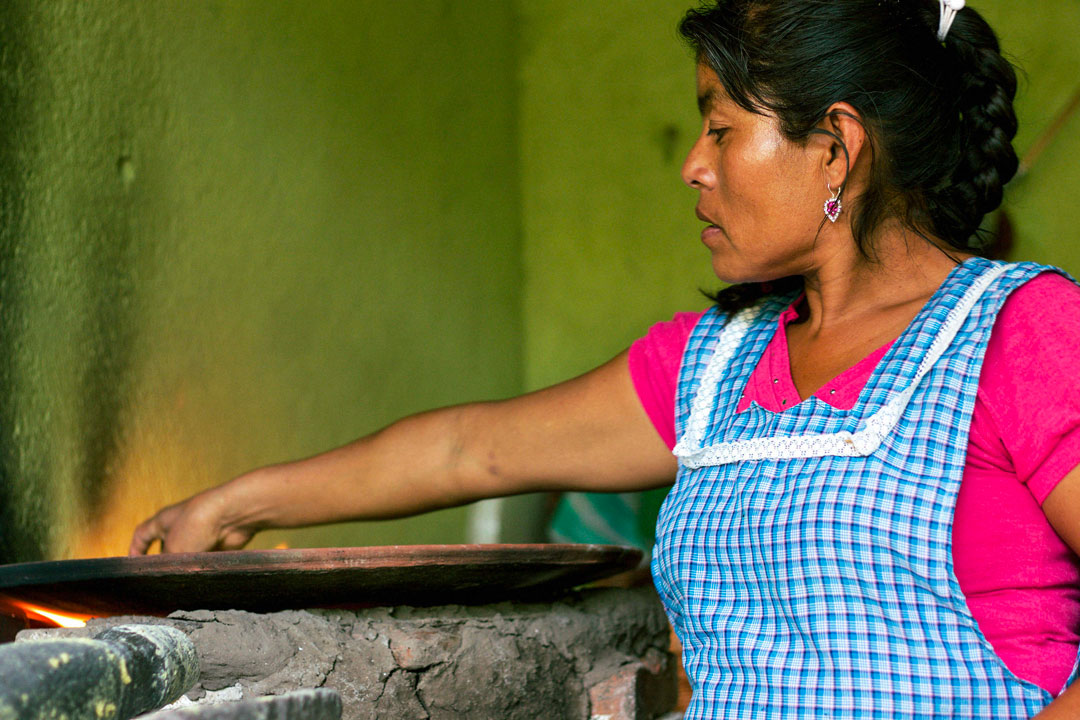
When the mole is creamy, abuelita adds capers, green olives, and raisins, followed by the cooked hen pieces. The kitchen fills with hands helping serve the rice in a perfectly formed cup size, a piece of chicken and a healthy dose of mole, all adorned with a sprig of cilantro. The poaching liquid for the chicken becomes a clear broth served with fresh herbs and pieces of the liver, heart, and small eggs from the hen’s womb.
We sit down at a long table amongst the birdcages and bushy plants, reflecting on the day’s work and the final meal. The emotional sacrifice of the animals, the meticulous butchering work, the detailed step-by-step of tortilla making, the layering of flavors in the creamy, sweet and salty mole, and perhaps most important, the willingness of these women to share a piece of their culinary heritage, and their kind invitation to join them at their table.
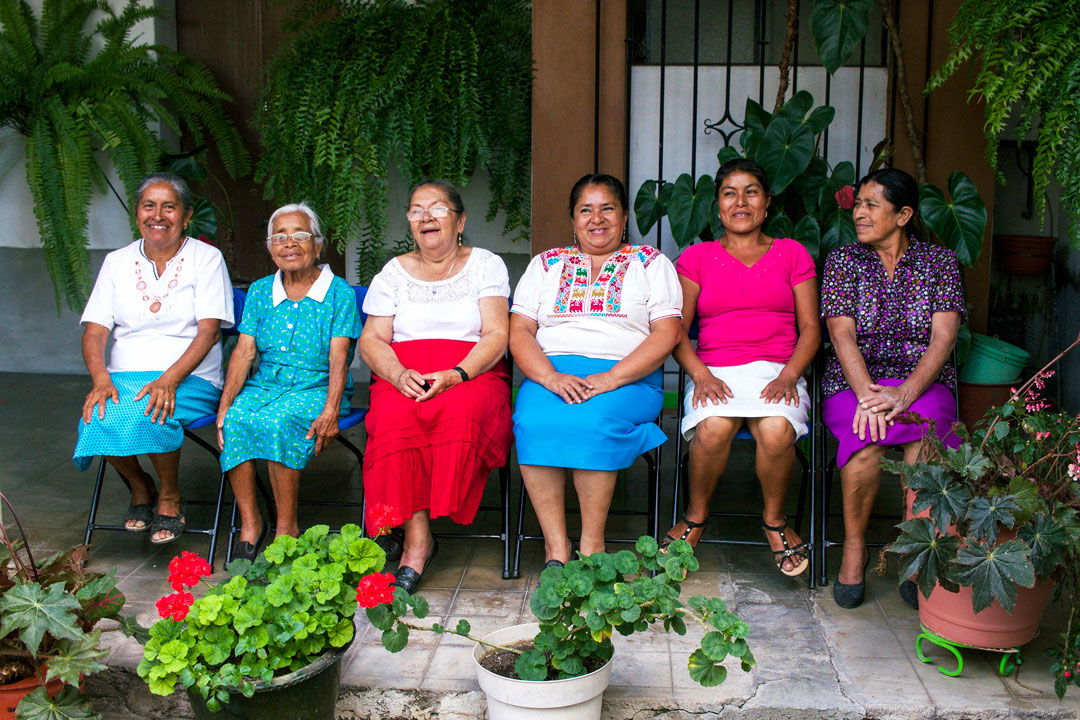
Estofado de Mole
 |
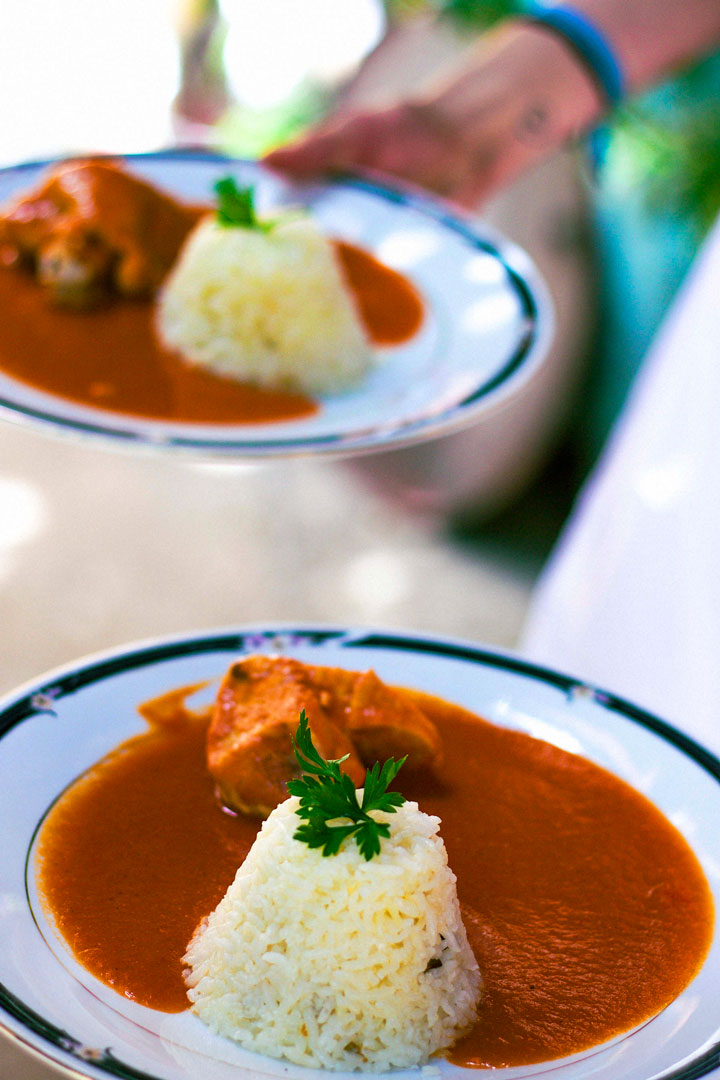 |
* Add dried chilies to your taste (our hostess kept them out, as she wasn’t sure if we could handle the heat)
Directions:
1- Place the tomatoes in a large pot over medium-low heat and allow them to burst and get soft.
2 -In a large sauté pan:
3- Pour the tomato mixture back into the pot, add the Bay leaf and cook on medium until it thickens.
4- In a separate pot, poach the chicken pieces in the 4 cups of water, salt and scallions.
5- Once the mole thickens, strain it and then add the capers, olives, raisins, and the chicken.
Serve with rice.
Acknowledgements
[1]This workshop was made possible by the partnership between the Instituto Universitario de Oaxaca and the hospitality department at Metropolitan State University of Denver. A special thanks to Dennis Carolina Davila Garcia from IUO, and her family in Ejutla del Crespo for welcoming us into their home. In honor of the memory of Abuelita.